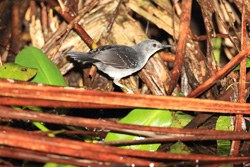Ecological competition affects animal signalling
The project 'The role of ecological competition in the evolution of animal signals' (AVIAN COMPETITION) investigated the interactions and differences between the two related bird species H. peruviana and H. subflava that live in the same habitat in Peru. Vegetation surveys and remotely sensed light detection and ranging data (LIDAR) were collected to determine differences in species ecology. Differences in bird morphology were assessed using measurements from ringed individuals, foraging strata, field observations and geographical information system (GIS) analyses. Scientists also accounted for diet overlap using stable isotope analysis of blood samples. The songs of Hypocnemis birds were recorded and mapped into a GIS from within and outside the species overlap area. This helped assess the influence of environmental factors and species interaction on song acoustic characteristics. Surprisingly, the two Hypocnemis species living in the same habitat had more similarity in song characters than with their own species living away from the contact zone. This provided compelling evidence for song convergence. As these birds are inter-specifically territorial, the differences in diet could be explained by variation in the type of arthropods (e.g. insects) present in their territory. Character convergence was confirmed through similar morphological measurements in the overlap area. Lack of hybridisation between species together with these findings demonstrate that these strong ecological competitors maintain territories and compete for resources within them. Project outcomes have opened up novel avenues for the investigation of evolutionary dynamics and species distribution. Understanding phenotypic similarity, ecological competition and territorial overlap effects on species distributions will have important implications for environment management and systems modelling.



